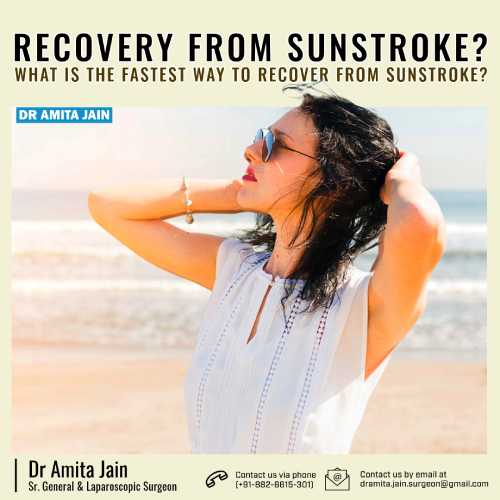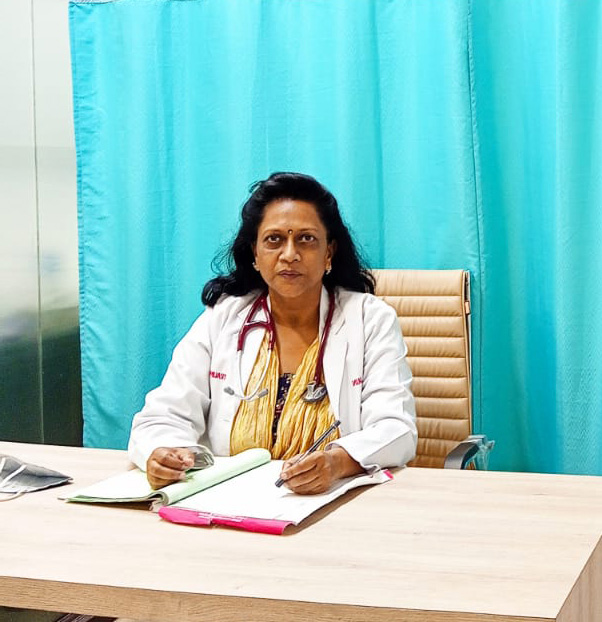Did you know that every year, soaring temperatures claim countless lives across various parts of India? As summer progresses, heat-related illnesses surge, with rising temperatures and intensifying heat waves heightening safety concerns.
The body’s ability to maintain temperature homeostasis, a process of thermoregulation that keeps core temperatures stable and ideal, is put under significant stress during extreme heat. When this thermoregulation system falters due to excessive heat, the body may fail to cool down properly, leading to heatstroke.
This condition can result in delirium, ataxia, seizures, multi-organ failure, and, in many cases, can be life-threatening or fatal.
So, what’s the fastest way to recover from sunstroke or heatstroke? Let’s find out from our medical expert, Dr Amita Jain, who is one of the leading and most experienced laparoscopic and general surgeons in Delhi.
We often come across the term heat exhaustion. Is it the same as heatstroke?
Heat exhaustion occurs when your body overheats. If left untreated, it can progress to heatstroke. Heatstroke is far more severe, with internal temperatures reaching at least 104°F. It can lead to shock, organ failure, or brain damage, and in extreme cases, it can be fatal.
Heat exhaustion typically doesn’t require emergency medical attention if you can cool down within 30 minutes. However, if it escalates to heatstroke, immediate treatment is crucial.
What is Heatstroke?
As explained earlier, Heat stroke is the most severe form of heat illness, occurring when the body’s natural cooling mechanisms, like sweating, fail to regulate its temperature. With rapid temperature escalation, up to 106 degrees Fahrenheit in as little as 10 to 15 minutes, it can lead to permanent disability or death.
Normally, the body cools itself through sweating, urination, and breathing, but when humidity surpasses 75%, sweating becomes ineffective.
What are the types of Heatstroke?
Heatstroke is of two types:
Exertional heatstroke is typically caused by intense physical exertion in hot weather when people spend too much time in outdoor activities.
Non-exertional heatstroke is when older adults, people with chronic illnesses and infants cannot adapt well to extreme heat while spending most of the time indoors without any physical activity.
What are the symptoms of heatstroke?
Some symptoms are:
- High fever (skin feels hot to the touch)
- Excessive sweating or dry skin that doesn’t sweat (anhidrosis)
- Muscle cramps
- Rapid pulse and heart rate
- Low blood pressure
- Rapid breathing
- Loss of balance
- Disorientation
- Irrational or erratic behavior
- Dizziness
- Headache
- Nausea and vomiting
- Dehydration (dry mouth and intense thirst)
- Low urine output or dark urine
- Physical collapse
- Coma
For babies and young children
- Fever of 103°F (39.4°C) or higher
- Loss of consciousness
- Hot, dry, or sweating skin
- Red, flushed-looking skin
- Rapid pulse or heart rate
- Shallow breathing
- Lethargy or sluggishness
- Confusion
Immediate medical attention is necessary if heatstroke is suspected, particularly in children, especially after exposure to high-heat environments.

What is the diagnosis?
Diagnosis could include:
- A couple of laboratory tests are performed for a proper diagnosis.
- Rectal temperature measurement is the most accurate method for determining core body temperature, surpassing mouth or forehead temperatures.
- Blood tests assess electrolyte levels (e.g., sodium, potassium) and gas content, aiding in identifying central nervous system damage.
- Urine tests observe color changes (often darker in heat-related conditions) and assess kidney function compromised by heatstroke.
- Muscle function tests detect severe muscle tissue damage, known as rhabdomyolysis, which can result from heatstroke.
- Imaging tests like X-rays examine internal organs for heatstroke-induced damage, offering insight into organ involvement.
What You Can Do Immediately?
Move the person to a cooler place such as an air-conditioned area or a shaded place.
You can Blow air over the person while dampening the skin with a wet sponge that will cause the water to evaporate and cool the body.
Ice packs or cold compresses can be applied to the patient’s armpits, groin, neck, and back to reduce body temperature effectively.
Warning: Ice should not be applied on older adults, young children or people with chronic illness. It is advisable to consult a doctor immediately.
No matter the severity or type, heatstroke demands swift action for recovery. Recognizing symptoms, seeking immediate medical attention, and employing cooling measures are paramount.
From infants to seniors, understanding the risks and interventions can save lives amidst rising temperatures, ensuring a safer summer for all.

Dr Amita Jain is a surgeon with highest degree of professional competence, precision and surgical craftsmanship. Performed all complicated general surgery procedures with in depth knowledge of invasive and few minimal invasive and onco surgical techniques. Underwent special training in trauma, executed various trauma-related complex life-saving neurosurgical procedures, reconstructed injured mangled limbs and performed vascular and reconstructive procedures with critical care.
Dr Amita Jain holds 28 plus years of rich experience in Trauma and General Laparoscopic Surgeries (including Gallbladder stone removal, appendix removal, hernia repair surgery, piles and fissure surgeries). She was the Professor Surgery of at the Army College of Medical Sciences and Base Hospital Delhi Cantt. In 1994 she was commissioned as Surgeon under the United Nations Mission in Congo. From 2020 to 2022, she worked with Bansals Hospital. Currently, Dr Amita Jain is the Senior Consultant, (Speciality: General and Laparoscopic Surgeon) at Artemis Lite Hospital, New Delhi
